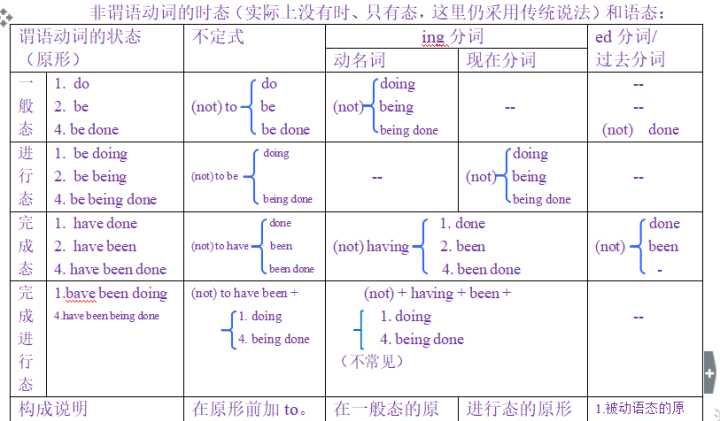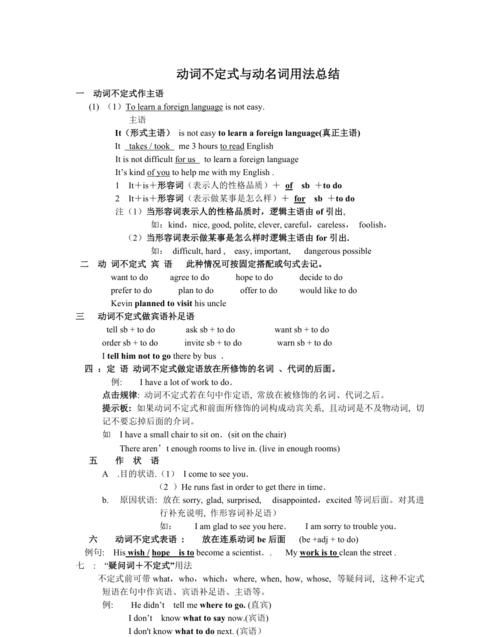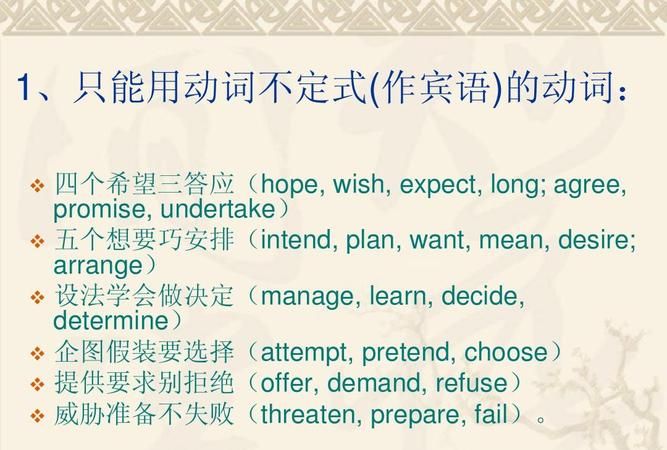本文目录
英语中什么是动词不定式
英语动词不定式有动词特征和非动词特征,这些特征在汉语句式中得到充分体现,本文探讨动词不定式与汉语句式之间的对应关系,提示语法句式组合的规律与法则与人们的思维方式有一定的关系。那么英语什么是动词不定式呢?下面是我整理的英语什么是动词不定式,欢迎阅读。
英语什么是动词不定式
在语法中,动词不定式是指动词的一种不带词形变化从而不指示人称、数量、时态的形式。它之所以被叫做不定式,是因为动词不被限定,或者说不被词形变化所局限。不定式属于非谓语动词。
然而在一些语言里(例如葡萄牙语),存在着受时态、人称和数量影响的不定式形态。亦有些语言完全没有不定式,例如阿拉伯语、保加利亚语和现代希腊语。
在外语学习的课程中,动词不定式的一般现在时被称作“词典用词”,因为它一般被用作词典中该动词的词头。
动词不定式可以作以上各种成分,但它毕竟是动词,所以有动词的属性。
动词不定式及其短语还可以有自己的宾语、状语,虽然动词不定式在语法上没有表面上的直接主语,但它表达的意义是动作,这一动作一定由使动者发出。这一使动者我们称之为逻辑主语。
英语中的动词不定式构成
动词不定式构成:to+ do(动词原形)
否定式:not to+do 动词原形
动词不定式特点:动词不定式没有人称和数的变化,在句子中不能独立作谓语。可以在句子中作主语、宾语、表语、宾语补足语、定语、状语.
一. 带to的不定式结构
1. 我们学过的能直接跟带to的不定式结构的动词主要有:want, ask, tell, hope, learn, try, decide, forget, remember, like , love, stop, go, come等。
二. 不带to的不定式结构
以下几种情况使用不带to的动词不定式:
1. 在固定词组had better之后。注意:had better的否定形式是had better not do sth.。 例如:You had better go home now. 你最好现在回家。
It's cold outside. You’d better not go out. 外面很冷,你最好不要出去。
2. 在let, make, see, feel, watch, hear等感官或使役动词后,要跟不带to的动词不定式作宾语补足语。
例如:I made them give me the money back. 我迫使他们把钱还给我。
I didn’t see you come in. 我没看见你进来。
3. 在引导疑问句的why not之后。
“Why not+不带to的不定式”是“Why don’t you do…”的省略,可以用来提出建议或劝告。 例如: Why not go with us? 为什么不和我们一起去呢?
Why not take a holiday? =Why don’t you take a holiday? 为什么不休假呢?
三.动词不定式的句法功能:
(一)作主语
不定式结构作主语时,现代英语倾向于采用it作形式主语,而把不定式结构后置的形式。 e.g. It’s easy (for me) to do that.
我做这事太容易了。
It’s so nice to hear your voice.
听到你的声音真高兴。
It’s necessary for you to lock the car when you do not use it.
当你不用车的时候,锁车是有必要的。
It’s very kind of you to help us. 承蒙惠助,不胜感激。
(二) 作宾语
在下列动词后用不定式作宾语:
afford; agree; ask; decide; want; expect; hope; fail; happen; help; learn;
mean; manage; offer; plan; promise; refuse; wish; forget; remember…
e.g. The driver failed to see the other car in time.
司机没能及时看见另一辆车。
It is raining hard. Jack is holding a newspaper over his head.
He forgot to take an umbrella.
雨下得很大。Jack头上顶着一张报纸。他忘记带伞了。
(三) 作宾语补足语
动词不定式作宾语补足语是动词不定式用法的一个重点,学习时要注意以下三种情况:
1. 作动词ask, like, tell等的宾语补足语时,动词不定式符号to不可以省略。 e.g. He asked me to talk about English study. 他请我谈谈英语学习的问题。
2. 作使役动词let, have, make以及感官动词feel, hear, see, watch等的宾语补足语时,动词不定式符号to要省略。
e.g. The teacher made him say the word like this. 老师让他像这样说这个单词。
3. 作动词help的宾语补足语时,动词不定式符号to可以带,也可以不带。
e.g. Could you help me (to) carry the heavy box? 你能帮我搬这个重箱子吗?
(四) 作定语
不定式作定语,要放在它所修饰的名词或代词的后面。
e.g. After he finished college, he had a lot of jobs to choose.
大学毕业之后,他有许多工作可选。
I have nothing to say on this question.
对这个问题我无可奉告。
He has something important to tell her.
他有重要的事情要告诉她。
(五) 作状语
动词不定式及其短语具有副词的特性,可在句中用作状语。
1. 放在句首也可以放在句尾表示目的等。
e.g. He stopped to have a rest. 他停下来休息。
2. 跟在作表语的形容词或过去分词的后面。
e.g. I’m sorry to hear that. 听到这事我感到很难过。
3. 用在too...to...结构中。
e.g. He is too young to understand it. 他太年轻,理解不了这件事。
动词不定式用法大全
一、结构:to+动词原形 (not +to+vt, 疑问词+to+vt)
二、功能:主语、表语、宾语、定语、补语、状语或单独使用。
三、特征:保留动词的某些特性,可以有自己的宾语、状语等构成不定式短语。
四、时态和语态
主动语态 被动语态
一般式 to do to be done
进行式
完成式 to be doing 无 to have done to have been done
They pretended not to see us.(一般式表示与谓语的动作同时/发生在它之后.)
He pretended to be sleeping.(在谓语动词发生的同时,不定式的动作也正在进行)
She pretended to have known it before.(完成式表示动作发生在谓语动作之前)
Do let your mother know all the truth. She appears_____ everything. ( 01年高考)
A. to tell B. to be told
C. to be telling D. to have been told
He is considered ____ the first computer.(MET93 34)
A. to invent B. inventing
C. to have invented D. having invented
五、用法
1、作主语
1) 用it作形式主语。(带疑问词的不定式不能用形式主语代替)
2)不定式可以有自己的逻辑主语,由for或of引出,加在不定式短语前面。
下列形容词做表语时,不定式的逻辑主语由 of 引出:
careless粗心的,clever聪明的,cruel残忍的,foolish愚蠢的,good好的,kind好心的 ,naughty淘气的,nice好的,polite礼貌的,right正确的,rude无礼的 ,silly愚蠢的,stupid傻的,unwise不明智的,wise明智的,wrong错误的
这些形容词都是描写人的性格和特点的形容词。“It is + 形容词 +of sb + to do sth”这样的句型更强调某人如何如何,可以改写为:“Sb + be + 形容词 + to do sth.” 而“for sb to do sth”这一结构更强调做某事如何如何。
注意:It is difficult for me to learn English. 更强调学英语很难,不能写成
I am difficult to learn English. (这句话含有逻辑错误。)
3)动词不定式作主语,谓语动词用第三人称单数形式。
As young adults, it is our duty to try our best to deal with each challenge. It was necessary to talk with his mother.
How to make requests politely is important.(不用it)
2、作表语
动词不定式作表语,常说明主语的内容、性质、特征。如:
1.The best way to improve your English is to join an English club.
2.The first thing is to greet the teacher.
3、作宾语
1)可以接带to的动词不定式作宾语的动词主要有:
要求选择同意(ask, choose, agree),期望决定学习(expect, hope, decide, learn),宁可假装知道(prefer, pretend, know),希望想要愿意(wish, want, would like / love) We decided to talk to some students about why they go there.
He prefers to eat white bread and rice.
Id love to visit Mexico.
2)feel, find, make, think等动词后有不定式作宾语且又带宾补时,要用it作形式宾语代替真正的宾语——动词不定式
I find it difficult to remember everything.
3)不定式与动名词作宾语的区别
A不定式作宾语表一次、数次的具体动作、将来动作或动作的全过程,ving形式表习惯性的连续动作、习惯性的动作。
1)Then I started to watch English-language TV.
2)I like to eat vegetables.
B接不定式或动名词作宾语意思不同的7个动词
(1) remember to do sth. 记住要做某事
remember doing sth. 记住曾做过某事
(2) forget to do sth. 忘记要做某事
forget doing sth. 忘记曾做过某事
(3) regret to do sth. 后悔(遗憾)要做某事
regret doing sth. 后悔(遗憾)曾做过某事
(4) try to do sth. 设法要做某事
try doing sth. 做某事试试看有何效果
(5) mean to do sth. 打算做某事
mean doing sth. 意味着做某事
(6) can’t help to do sth. 不能帮助做某事
can’t help doing sth. 禁不住做某事
(7) go on to do sth. 做完某事后接着做另一事
go on doing sth. 继续做一直在做的事
(8)stop to do sth. 停下来去做某事(目的状语)
stop doing sth. 停止正在做的事,。
When I left home, I had forgotten to bring it with me.
I stopped using them last year.
3、作补语
1) 带to的不定式作补语的动词主要有:要求允许提议(ask, allow, permit, advise),期望邀请鼓励(expect, suppose, invite, encourage),教导告诉想要(teach, tell, want),等待希望愿意(wait for, wish, would like / love)。如:
I'd invite her to have dinner at my house.
Teenagers should be allowed to choose their own clothes.
2)不带to不定式作补语,多数动词是感官动词和使役动词,包括五“看”:look at, observe, see, watch,notice三“让”:have, let, make,二“听”:hear, listen to,一“感觉”:feel。另外find如:
Your word makes me feel happy!
we want to see Liu Yu achieve his dreams.
但在被动语态句里带to如:
He was seen to smoke here.
He was found to steal in the shop.
3)有些动词如: permit ,allow,admit,forbid,imagine,consider 后接不定式作宾补,接动名词作宾语即V + sb to do sth & V + doing sth
e.g. :
The doctor advised me not to go to bed too late.(建议)
Please permit me to introduce myself to you first.允许
You surely can't consider him to be a selfish man.认为
My parents forbid me to stay out after mid-night.禁止
I allowed the children to play in my room for another five minutes.让
advise/permit/allow/admit/forbid/consider doing sth.
The little boy admitted having broken the glass.承认
They shouldn't allow parking in the street ; it's too narrow.允许
I forbid smoking in my house.禁止
We do not permit smoking in the office.允许
4、作定语
1) 用不定式作定语的几种情况:
A不定式表将来:
I borrowed some books to read during my holiday.
B用来修饰被序数词、最高级或no, all, any 等限定的中心词。如:
He was the best man to do the job.
He was always the first to come and the last to leave.
She was the first woman to win the gold medal in the Olympic Games.
Women and children were the first to get into the lifeboats.
C 用来修饰的词是抽象名词时,常见的有:ability, chance, idea, fact, excuse, promise, answer, reply, attempt, belief, way, reason, moment, time 等。如:
Do you have the ability to read and write English ?
I have a chance to go sight –seeing.
2) 作定语的不定式如果是不及物动词,或者不定式所修饰的名词或代词是不定式动作的地点、工具等,不定式后面须有相应的介词。如:
The Browns have a comfortable house to live in.
There is nothing to worry about.
Please give me a knife to cut with.
I need a piece of paper to write on. 我需要一张写字用的纸。
但是,不定式所修饰的名词如果是time, place 或way时,不定式后面的介词习惯上省去。
如:He had no money and no place to live (in).
We found a way to solve this problem (in).
2) 当作定语的不定式所修饰的名词或代词是不定式动作的承受者时,不定式既可以用主动语态,也可用被动语态,但其含义有所不同。试比较:
Have you anything to send ? 你有什么东西要寄吗?(不定式to send 的动作执行者是“你”) Have you anything to be sent ? 你有什么要(我或别人)寄的东西吗?
5、作状语
1)目的状语,置于句首或句末,置于句首时常表示强调。如:
I study hard to improve my English.
A group of young people got together to(in order to / so as to) discuss this question. so as to do一般不置于句首,还可以引导结果状语从句
2)原因状语,多见于“sb.+be+adj.+to do...”结构句中。如:
I feel very lucky to have the gift.
He had run out of money to buy old bikes.
3)结果状语,多见于“too...to”,“enough to...”结构句中。如:
Then I’m too tired to do well. What should I do?
The room needs to be big enough for three people to live in.
6、不定式主动表被动
1)在某些固定句型中, 动词不定式作定语, 用主动形式表被动意义。
(1)have(give, show, find )sth. to do
在这种句型中的不定式与前边的名词有动宾关系, 又和句中另一名词或代词构成主谓关系。
例如: I have a lot of things to do this afternoon. to do与things是动宾关系, 与I是主谓关系。否则, 在表示被动意义时, 仍需要被动式。试比较:
Have you anything to do this afternoon? 今天下午你有事要做吗? (to do是由you发出的)
Have you anything to be taken to your parents? 你有要带给你父母的东西吗? (谁带不得而知) Please get me something to read. 请给我弄点读的材料。
(2)It(This, That)+be+a/an+adj. + n. +to do
在这种句型中, 不定式与前面的名词有动宾关系。动词不定式可改为动词不定式复合结构。 例如: This is a difficult question to answer. 这是个难答的问题。
question与to answer为动宾关系。to answer可改为 for me to answer。再如:
It is an easy sentence to translate. 这个句子很容易翻译。
(3)There +be +n. +to do
在此句型中, 用来修饰主语的不定式, 可用主动式, 也可用被动式, 只是侧重点不同。用主动式作定语, 重点在人, 用被动式作定语, 重点在物。
例如:没有时间可以耽误。可译成:There is no time to lose(to be lost). 用 to lose可看成for us to lose; 用to be lost, 谁 lost time不明确。
但下述两句用主动不定式与被动不定式意义不同:
a. There is nothing to do now. (=We have nothing to do now. )现在没事干。
b. There is nothing to be done. (=We can do nothing now. )现在没办法了。
a. There is nothing to see. (nothing worth seeing)没有东西值得看。
b. There is nothing to be seen. (nothing there at all)看不见什么东西。
2)在某些“形容词+不定式”的结构中, 不定式有被动意义, 与句子主语构成动宾关系。其句型有:
(1)n. +be+adj. +to do
The job is very easy to do. 这工作很容易做。
(2)n. +be+too+adj. +to do
The thing is too small to see. 这东西太小看不见。
(3)n. +be +adj. +enough to do
The book is cheap enough to buy. 这本书很便宜可以买。
3)某些动词, 如to let, to blame (责备), to seek(寻找)用主动式表被动意义。
例如:
The house is to let. 这房子要出租。
Who is to blame for it? 这得怪谁?

动词不定式的用法
动词不定式用法总结 动词不定式在句中可充当主语、表语、宾语、宾补、定语和状语等。
一、作主语
动词不定式作主语可位于句首。例如:
To learn a skill is very important for everyone in society.
也可使用it作形式主语,而将其置于句末。例如:
It is necessary for young students to learn a foreign language.
动词不定式作主语的常用句型有:
1. It is+adj./ n. (+for sb./sth.) + to do sth.
用于此句型的形容词有:easy, hard, difficult, possible, important, impossible, necessary, good, bad, exciting, interesting, surprising等。例如:
It is interesting to play this game.
It is necessary for you to change your job.
It was impossible for them to complete the task in such a short time.
考例1:Is ____ possible to fly to the moon in a spaceship? (88 MET)
A. now B. man C. that D. it
用于此句型的名词有:pity, shame, pleasure, one’s duty, one’s job, fun, joy, good manners, bad manners等。例如:
What a pity it is for you to have missed such a wonderful film.
It is good manners for the young to give their seats to the old.
2. It is+adj.+of sb.+to do sth.
该句型中只能使用描述某人的品德、特征的形容词,如: kind, nice, wise, silly, polite, impolite, friendly, foolish, clever等。例如:
How rude it was of the boy to jump the queue!
It is friendly of the family to try to make me feel at home in their house.
How silly it was of you to give up such a good chance!
3. It takes sb.+some time+to do sth.
该句型意为“做某事花费某人多长时间”。例如:
It took us half an hour to ride to the town by bike.
二、作表语
动词不定式作表语常用于以下结构:My wish/ job/ aim/ goal is…及The next step/ measure is …等。例如:
Your job is to type the papers in the office.
The next measure is to stop the river from being polluted.
三、作宾语
常见的只能使用动词不定式作宾语的动词有:agree, choose, decide, hope, fail, wish, refuse, expect, manage, plan, intend, pretend, promise, offer, afford, demand, arrange等。 例如:They decided to build a highway between these two cities.
She offered to help me when I was in trouble.
believe, think, consider, feel, make等动词可用于“动词+ it +adj. / n+to do sth.”句型,其中使用it作形式宾语,而将真正的宾语动词不定式置于句末。例如:
I think it necessary for us to have a good rest after the long work.
She felt it her duty to help the old woman.
四、作宾补
可后接动词不定式作宾补的动词有:advise, allow, ask, hear, order, see, tell, want, wish, watch等。例如:
The doctor advised her no to eat too much sugar.
I wish you to go to the meeting with me.
believe, consider, count, declare, deny, feel, find, guess, imagine, judge, know, prove, realize, suppose, think等动词后可接to be型不定式作宾补。例如:
He declared himself to be a college student. 他自称是名大学生。
The police proved him to be a thief. 警察局证实他是小偷。
hope, demand, suggest等动词不能后接动词不定式作宾补。例如:
【误】I hope my son to be back soon.
【正】I hope my son will be back soon.
【误】She suggests us to have a discussion about it.
【正】She advises us to have a discussion about it.
【正】She suggests that we (should) have a discussion about it.
在主动结构中,下列动词后作宾补的动词不定式应省略to:“五看”(see, watch, notice, observe, look at)“三使”(make, let, have)“两听”(hear, listen to)“一感觉”(feel)。例如:
Who made him work all night long?
但是,改为被动结构后,应补出省略的to。例如:
He was seen to break the window.
五、作定语
动词不定式作定语,应位于所修饰词语之后,即:作后置定语。例如:
Have you got anything to eat? (to eat修饰anything,位于其后)
下列名词后常接动词不定式作定语:ability, attempt, chance, courage, decision, effort, failure, promise, way, wish等。例如:
But she gave up the chance to go abroad.
由only, first, last, next以及序数词或形容词最高级修饰的名词后,也常接不定式作定语。例如:
Who was the last one to leave the classroom last night?
六、作状语
动词不定式作状语,可表示目的、原因、结果或条件。例如:
We went there to see our grandparents.(目的)
I am very sorry to hear that.(原因)
She hurried home only to find her father dead.(结果)
To look at the picture, you would like it.(条件)
作目的状语,还可以使用in order to或so as to。例如:
The boy worked so hard in order to make up for the lost time.
结果状语还可以使用enough to, too…to…, so…as to, such… as to等结构。例如:
He got up too late to miss the early bus.
She was in such a hurry as not to notice me. 她如此匆忙,以致没有注意到我。

动词不定式的用法总结
动词不定式的用法
在初中时,我们就学过动词不定式,现就其用法归纳如下。
动词不定式在句中可充当主语、表语、宾语、宾补、定语和状语等。
一、作主语
动词不定式作主语可位于句首。例如:
To learn a skill is very important for everyone in society.
也可使用it作形式主语,而将其置于句末。例如:
It is necessary for young students to learn a foreign language.
动词不定式作主语的常用句型有:
1. It is+adj./ n. (+for sb./sth.) + to do sth.
用于此句型的形容词有:easy, hard, difficult, possible, important, impossible, necessary, good, bad, exciting, interesting, surprising等。例如:
It is interesting to play this game.
It is necessary for you to change your job.
It was impossible for them to complete the task in such a short time.
考例1:Is ____ possible to fly to the moon in a spaceship? (88 MET)
A. now B. man C. that D. it
用于此句型的名词有:pity, shame, pleasure, one’s duty, one’s job, fun, joy, good manners, bad manners等。例如:
What a pity it is for you to have missed such a wonderful film.
It is good manners for the young to give their seats to the old.
2. It is+adj.+of sb.+to do sth.
该句型中只能使用描述某人的品德、特征的形容词,如: kind, nice, wise, silly, polite, impolite, friendly, foolish, clever等。例如:
How rude it was of the boy to jump the queue!
It is friendly of the family to try to make me feel at home in their house.
How silly it was of you to give up such a good chance!
3. It takes sb.+some time+to do sth.
该句型意为“做某事花费某人多长时间”。例如:
It took us half an hour to ride to the town by bike.
二、作表语
动词不定式作表语常用于以下结构:My wish/ job/ aim/ goal is…及The next step/ measure is …等。例如:
Your job is to type the papers in the office.
The next measure is to stop the river from being polluted.
三、作宾语
常见的只能使用动词不定式作宾语的动词有:agree, choose, decide, hope, fail, wish, refuse, expect, manage, plan, intend, pretend, promise, offer, afford, demand, arrange等。 例如:They decided to build a highway between these two cities.
She offered to help me when I was in trouble.
believe, think, consider, feel, make等动词可用于“动词+ it +adj. / n+to do sth.”句型,其中使用it作形式宾语,而将真正的宾语动词不定式置于句末。例如:
I think it necessary for us to have a good rest after the long work.
She felt it her duty to help the old woman.
四、作宾补
可后接动词不定式作宾补的动词有:advise, allow, ask, hear, order, see, tell, want, wish, watch等。例如:
The doctor advised her no to eat too much sugar.
I wish you to go to the meeting with me.
believe, consider, count, declare, deny, feel, find, guess, imagine, judge, know, prove, realize, suppose, think等动词后可接to be型不定式作宾补。例如:
He declared himself to be a college student. 他自称是名大学生。
The police proved him to be a thief. 警察局证实他是小偷。
hope, demand, suggest等动词不能后接动词不定式作宾补。例如:
【误】I hope my son to be back soon.
【正】I hope my son will be back soon.
【误】She suggests us to have a discussion about it.
【正】She advises us to have a discussion about it.
【正】She suggests that we (should) have a discussion about it.
在主动结构中,下列动词后作宾补的动词不定式应省略to:“五看”(see, watch, notice, observe, look at)“三使”(make, let, have)“两听”(hear, listen to)“一感觉”(feel)。例如:
Who made him work all night long?
但是,改为被动结构后,应补出省略的to。例如:
He was seen to break the window.
五、作定语
动词不定式作定语,应位于所修饰词语之后,即:作后置定语。例如:
Have you got anything to eat? (to eat修饰anything,位于其后)
下列名词后常接动词不定式作定语:ability, attempt, chance, courage, decision, effort, failure, promise, way, wish等。例如:
But she gave up the chance to go abroad.
由only, first, last, next以及序数词或形容词最高级修饰的名词后,也常接不定式作定语。例如:
Who was the last one to leave the classroom last night?
六、作状语
动词不定式作状语,可表示目的、原因、结果或条件。例如:
We went there to see our grandparents.(目的)
I am very sorry to hear that.(原因)
She hurried home only to find her father dead.(结果)
To look at the picture, you would like it.(条件)
作目的状语,还可以使用in order to或so as to。例如:
The boy worked so hard in order to make up for the lost time.
结果状语还可以使用enough to, too…to…, so…as to, such… as to等结构。例如:
He got up too late to miss the early bus.
She was in such a hurry as not to notice me. 她如此匆忙,以致没有注意到我。
hope it can help you!

动词不定式的时态语态形式及用法
一、动词不定式
动词不定式的基本形式是“to+动词原形”,有时可以不带to.动词不定式没有人称和数的变化,在句子中不能作谓语,但可以担任主语、表语、宾语、状语和宾语补足语.动词不定式仍保留动词的一些特点.
(一)动词不定式的特征及用法
1.动词不定式的构成及特征
“to +动词原形”构成动词不定式,是一种非谓语形式,在句子中不能作谓语,没有人称和数的变化,它具有名词、形容词和副词的特征.
2.动词不定式的用法
动词不定式具有名词、形容词和副词的特征,在句子中可以作主语、表语、宾语、定语和状语.
1. 作主语
例如:To learn English well is not easy.
或 It is not easy to learn English well.
动词不定式作主语时,往往用it作形式主语,这种句型可归纳为下面的句型:
It is + adj.+ 动词不定式
如果要说明不定式的动作执行者,可以用for
It is + adj.+ for sb. to do sth.
2. 作表语
My wish is to become a teacher.
3. 作宾语
Most of us like to watch football matches.
4. 作宾语补足语
He told me to be here on time.
5. 作定语
I have nothing to say about that thing.
6. 作状语
He stopped to have a look.
3.动词不定式的否定形式
动词不定式的否定形式not + to + 动词原形
例如: He asked me not to make such a mistake.
4.动词不定式与疑问词连用
疑问代词who, what, which和疑问副词when, where, how, why等后面可以接动词不定式,构成动词不定式短语,可以在句子中作主语、宾语、表语等成分.
例如:(1) He doesn’t know how to use the machine.
(不定式作宾语)
(2) How to use the machine is a question.
(不定式作主语)
(3) The question is when to go there.
(不定式作表语)
(二)动词不定式的时态和被动形式
动词不定式是非谓语动词的一种,由不定式符号(to)加动词原形构成.不定式的形式有五种:
1. 一般式to do
例如:I like to read English.
2. 进行式to be doing
例如:He seemed to be reading something at that time.
3. 完成式to have done
例如:He seemed to have cleaned the room.
4. 被动式to be done
例如:The work is to be done soon.
5. 完成被动式to have been done
例如:The boy is said to have been sent to hospital yesterday.
复习时需注意的要点
1. 动词不定式一般式表示的动作可能与谓语动词的动作同时发生,也可能在其之后发生.
例如:I saw the young man enter the house.(同时发生)
I hope to go there next time.(之后发生)
2.不定式完成式表示不定式的动作在谓语动词之前发生.
例如:I’m sorry to have broken your glasses.
3.不定式进行式表示不定式的动作,与谓语动词同时发生.
例如:When he came in, I happened to be reading at the table.
4.不定式的被动式有两种形式:to be done表示将要被做,to have been done表示已被做.
例如:The new cinema to be put up next year will be very large.
The cinema is said to have been built last year.
5. 在表示情绪的动词,如like, love, hate, prefer等后,用动名词作宾语表示一般倾向,用不定式表示特定某事.但在would/should like/love/prefer后要用不定式
例如:I hate eating the same food every day.
Would you like to watch TV in the evening?
6. 在动词need, want, require后用动名词表示被动含义,相当于动词不定式的被动式;而用动词不定式的主动式表示主动含义.
例如:The house needs cleaning. = The house needs to be cleaned.
He needs to clean the house first.
7. 在介词后一般用动名词作宾语,但在少数介词,如but, except后用动词不定式作宾语,但要注意“to”的省略,如but前有“do”则省去“to”.
例如:I have done nothing but help him with his luggage.
I have no choice but to wait for him at the bus stop.
历届高考试题分析
例1、The discovery of new evidence led to _________.
A. the thief having caught B. catch the thief
C. the thief being caught D. the thief to be caught
答案为C.
【解析】 lead to这个词组中to是介词,后面跟名词,于是B被排除,the thief是动名词逻辑上的主语,构成动名词的复合结构,与catch之间应是被动关系,故排除A.常见的带介词to的短语有:(get) be used to, look forward to,look up to, stick to, object to, be devoted to, pay attention to等.
例2、Though _______money, his parents managed to send him to university.
A. lacked B. lacking of C. lacking D. lacked in
答案为C.
【解析】 lack是及物动词,后接宾语money.his parents与lack是逻辑上的主谓关系,要用现在分词作状语.译文:虽然缺钱,他的父母亲还是设法让他上了大学.
例3、He got well-prepared for the job interview, for he couldn’t risk ____ the good opportunity.
A. to lose B. losing C. to be lost D. being lost
答案:B
【解析】 risk后面只能带动名词做宾语,含义为“冒……之险”.
例4、 _____ to sunlight for too much time will do harm to one's skin.
A. Exposed B. Having exposed C. Being exposed D. After being exposed
答案为C.
【解析】 在非谓语动词中,用动名词或不定式来作主语,而分词和介词短语不能作主语,因此A、D被排除.在这个句子中,will do是谓语,缺少主语,要用动名词作主语.expose与one's skin是动宾关系,所以要用动名词的被动式being exposed.译文:在阳光下晒太长时间对人的皮肤有坏处.
例5、____ into use in April 2000, the hotline was meant for residents reporting water and heating supply breakdowns.
A. Put B. Putting C. Having put D. Being put
答案:A
【解析】 put sth. into use “让……投入使用”.显然,put 和句子主语the hotline 构成被动关系,所以用表示被动的过去分词.
例6、It was unbelievable that the fans waited outside the gym for three hours just ____ a look at the sports stars.
A. had B. having C. to have D. have
答案:C
【解析】 动词不定式充当目的状语.
例7、With a lot of difficult problems _______, the newly-elected president is having a hard time.
A. settled B. settling C. to settle D. being settled
答案为C
【解析】动词不定式to settle作为difficult problems的定语表示现在或将来要解决的难题;过去分词settle作定语表示已经解决的难题,现在分词的被动式being settled作定语表示正在解决的难题.
例8、More and more people are signing up for Yoga classes nowadays, ____ advantage of the health and relaxation benefits.
A. taking B. taken C. having taken D. having been taken
答案:A
【解析】 take advantage of (利用)和句子主语More and more people 构成主动关系,且和句子谓语sign up for (报名参加)同时发生,所以选择A.
例9、 Sandy could do nothing but ________ to his teacher that he was wrong.
A. admit B. admitted C. admitting D. to admit
答案为A.
【解析】 该句中的but是介词,后接动词不定式.当谓语动词是do,does或did时,后接不带to的不定式;是其他动词时,后接带to的不定式.该句的谓语是could do nothing,要填动词原形admit.译文:山德不得不向老师承认自己错了.
例10、 He sent me an e-mail, ________ to get further information.
A. hoped B. hoping C. to hope D. hope
答案为B.
【解析】 现在分词hoping表示与send me an e-mail同时发生的动作.一些考生认为应该填不定式作目的状语.不定式作目的状语时,句子的正确形式是:He sent me an e-mail to get further information.不需要hope一词,如果要选择“hoped”时,句子的正确形式是:He sent me an e-mail and hoped to get further information.“hope”和“sent”作并列谓语.

以上就是关于动词不定式的句型 ,英语中什么是动词不定式的全部内容,以及动词不定式的句型 的相关内容,希望能够帮到您。

